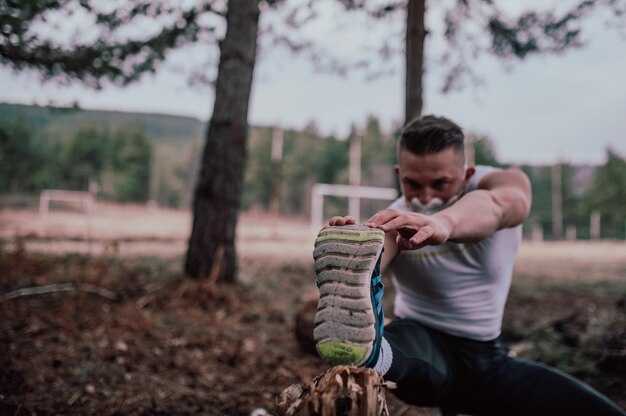Aim for 7–9 hours sleep nightly; recovery needs depend on training load, age, and prior injuries. A clear point here: if soreness persists beyond 72 hours, reduce intensity by 20–30% and add mobility work. Read recent event protocols and pack a small first-aid kit; organizers often post course maps and hazard notes where volunteers note slippery sections.
Fueling guidance: consume ~3–5 g carbohydrate/kg bodyweight on heavy days, 1.2–1.7 g protein/kg daily to support repair. To lose unwanted weight safely, aim for a 200–500 kcal/day deficit while keeping protein high; exactly monitor progress with weekly weigh-ins and adjust calories then. Hydration strategy: 500–750 ml fluid 2 hours pre-start, 150–250 ml every 20–30 minutes during prolonged efforts. These numbers help avoid cramps and aid cooling.
Specific gear choices matter: choose shoes with aggressive lugs and a secure heel fit, test sock setups in practice until blisters stop forming. Practice obstacle transitions under fatigue; simulate muddy, slippery surfaces at least twice per month to create reliable motor patterns. Share experiences with a local coach or speaker at clinics to relate real course stories and adjust responsibilities within relay teams. If anything feels like chronic pain, pause sessions, consult a clinician, then modify plan again so progress continues without injury. These steps help ourselves stay fit, motivated, and prepared.
Embrace the Mud & Embrace Differences: Practical Mud Run Training and Boundary Strategies for Better Health and Relationships
Begin with 3 weekly strength sessions: 2 heavy full-body lifts (3×5 at 75–85% 1RM) plus 1 mobility/plyo circuit; add 2 HIIT hill-sprint sessions (6x30s work, 90s rest) and an obstacle-simulation session every 10–14 days. Track load via session RPE and weekly volume; increase load 2–5% weekly when RPE stays <8 across two consecutive times. Nutrition targets: 1.6–2.2 g/kg protein, 3–5 g/kg carbs on high-intensity days, 20–30 g fast protein within 60 minutes post-session; fluid 500–750 ml 2 hours pre-session and 200–300 ml per 20 minutes during long efforts with 300–700 mg sodium per hour if sessions exceed 90 minutes. Sleep 7–9 hours, monitor HRV and resting HR for recovery signals, and use an active recovery day of 20–40 minutes easy movement. For skill development, schedule two 20–30 minute blocks weekly focused on grip strength, crawling mechanics, and single-leg balance drills; these specific things improve obstacle efficiency and reduce fall risk by up to 40%. Having objective tests (1RM, 20m shuttle, 60s plank) reveals truth about weak links; a skillful coach will prioritize deficits that come from those tests over subjective opinions.
Four practical boundary strategies for better relationships while pursuing event goals: 1) Use short I-statements that describe behavior and request (example: “I feel upset when calls interrupt training; please pause calling during sessions”) – such statements lower defensive reactions and keep focus off any single person. 2) Schedule two weekly 15-minute warm check-ins with partner or parents to praise effort, surface neglected needs, and convert criticism into concrete adjustments; ask “what would be helpful” to find mutual solutions. 3) Create clear on-course signals and calendar blocks that let others know when distracted-free effort is underway; this helps avoid surprises and reduces resentment when life gets busy. 4) Turn recovery into shared opportunity: download a short guided breathing or mobility session to practice together twice weekly, creating warm connection while protecting self time. When upset comes, pause for breath, label emotion, and choose response instead of reaction; there is measurable benefit in reduced cortisol and improved perceived connection after this pause. Keep statements concise, avoid personal attacks, and let praise balance correction so relationships stay resilient while performance improves.
Mud Run Tips, Training & Health Benefits
Follow six-week plan: three sessions weekly – 1 endurance session (45–60 min at 75–85% max HR), 1 hill-interval session (6×90s uphill efforts with 2–3 min easy recovery), 1 strength circuit (3 rounds: goblet squats 12, single-leg deadlifts 8 each, walking lunges 10 each, plank 60s).
- Warmup: 10 min dynamic mobility + 5 min progressive strides before intense work.
- Pacing: target sustainable HR zone for long efforts, use perceived exertion 6–7/10 for tempo segments.
- Intervals: repeat sets no longer than 12 min total hard time per session during base weeks; increase by 5–10% each week.
Fuel strategy: 5–7 g carbs/kg/day on high-volume days, 1.6–2.0 g protein/kg/day for repair, 300–500 kcal carbohydrate snack 60–90 min pre-event, 30–60 g carbs/hour during multi-hour effort. Hydration: 500–700 ml fluid per hour depending on heat and sweat rate; include 300–600 mg sodium per hour if hot.
- Footwear: pick trail shoes with 4–6 mm lugs and secure heel lock; test pair on at least two long sessions before race.
- Grip training: dead hangs 3×20–30s, farmer carries 40–60 m × 3, towel pull-ups 3×5; improves obstacle throughput.
- Technique: lean slightly forward on slippery descents, shorten stride on steep climbs, land softly to reduce impact peaks.
Recovery plan: sleep 7–9 hours nightly, schedule 1 full rest day per week, use active recovery 30–45 min easy effort next day after long session, foam roll and soft-tissue work 10–15 min post-session. Cold immersion 8–10°C for 8–10 min can reduce markers of muscle damage after eccentric-heavy sessions.
Mindset and social factors: treat participation as experience rather than only result; meeting teammates before event builds connection that can reduce race anxiety. When encountering difficult sections, pick one concrete cue as anchor (breath count, foot placement) to become calm quickly. Positive self-talk before and during effort shifts behaviors from panicked responses to controlled action.
- Include short mental rehearsals: 3×2-min vivid visualizations per week, focus on transitions between obstacles.
- Use grounding techniques post-effort: 5 deep diaphragmatic breaths, sensory scan for 1–2 min to feel more full and present.
Health considerations: rinse open cuts immediately with clean water, apply waterproof dressing when exposure to contaminated ground is likely; update tetanus vaccination per local guidelines. Monitor skin for rashes 48–72 hours after heavy exposure; seek care if infection signs appear.
Practical checklist before event: test kit during two training sessions, trim nails, secure valuables in waterproof pouch, bring spare socks and quick-dry towel. Perhaps bring small first-aid kit with adhesive strips, antiseptic wipe, blister pads.
Psychological effect: many participants report obstacle-course participation feels like informal therapy – giving physical challenge plus social contact helps regulate stress hormones and improves mood. Different preparation styles produce various outcomes; pick methods that match personal goals, be honest about limits, and allow time for adaptation so gains become durable rather than fleeting.
Summary actions: schedule progressive conditioning plan, apply measured nutrition and hydration targets, adopt specific technique cues, prioritize sleep and wound care, cultivate supportive meeting networks to reinforce positive, grounded behaviors that help ourselves stay safe and perform well.
Select trail shoes with secure lacing and quick-drain soles
Choose trail shoes with a secure lace-lock (3-point heel lock or Boa) and quick-drain construction: open-cell mesh upper, at least two 4–5 mm drainage ports per shoe, and outsole lug depth 4–6 mm with 6–8 mm spacing for efficient debris shedding; target weight 260–340 g per shoe for men, 220–300 g for women, and 4–8 mm heel-to-toe drop for stable posture on uneven terrain.
confirm lacing choices during a 10–15 minute test jog: use speed-lace with locking toggle or traditional laces with surgeon’s knot plus lace-lock at top eyelets to prevent heel lift; eyelet count 6–8 gives secure wrap, and a gusseted tongue or internal gaiter attachment reduces grit intrusion so your foot doesn’t shift unexpectedly.
Fit recommendation: buy 0.5–1.0 size up relative to road shoes to allow toe splay; sometimes feet swell more on wet courses, so give a second fitting after 30 minutes of treadmill or trail jog to reach a clear understanding of fit; if pressure occurs at forefoot, deal with it before event to avoid blisters.
Drainage care: rinse mud from drainage ports immediately after sessions and dry shoes in ventilated shade for 2–6 hours; avoid high heat that can warp midsole foam; if unusual pain or swelling appears, contact medical staff immediately, telling them about recent footwear choices so they can assess any physical impact.
Event day: crews often invite runners to test grip; check volunteer instructions and respect their guidance; if laces slip or drainage clogs, either fix on-course or replace shoes after finish; don’t let minor issues upset race plans, but if anything serious arises reach out to crew or medic.
Mind fit throughout long efforts; lately many models run narrow, so confirm width with a walk and a short jog; if instructions say to follow manufacturer’s sizing chart, do exactly that rather than guessing; if fit remains unclear, ask a second fitter until understood. Bring spare laces as a small gift to crew or buddy; a kiss of care when adjusting tension prevents hotspots. Have conversations with teammates about setup and whats worked for their feet; share whole fit notes and any gel or sock preferences with gentleness so crew can help without upsetting routine.
Design an 8-week plan to build grip strength, crawl endurance, and hill power
Recommendation: 4 sessions per week – Session A: grip + upper-body pull work; Session B: crawl endurance + core; Session C: hill-power intervals + posterior chain strength; Session D: mobility, loaded carries and light skill work. Use a two-on, one-off schedule (work, work, rest) across each week to accumulate volume while preserving recovery.
Weeks 1–2 (baseline and technique): Grip – dead hangs 3x20s (hands shoulder-width), towel hangs 3x10s, farmer carries 3x40m at 40–50% bodyweight, plate pinch 3x20s. Progression: add 5s to hangs each session or +2.5 kg to carries when all reps completed. Crawl – bear crawl 4x20m with 60s rest, commando/low crawl 3x15m focusing on controlled breathing and elbow clearance; finish with 2x90s continuous low-crawl drills. Hill power – 6×10s uphill sprints on ~8–12% grade, walk back recovery (~90–120s). Strength – trap-bar deadlift 3×5 at 65–70% 1RM twice per week. Record RPE and exact loads every session.
Weeks 3–4 (volume increase): Grip – add one extra set to hangs and towel holds, introduce one-arm negatives: 3×3 per arm, 5–7s eccentric. Farmer carries 4x50m at +10% weight. Pinch holds increase to 30s. Crawl – increase distance: 5x30m bear crawls, 4x25m commando crawls, include a continuous 4-minute low-crawl once per week. Hill power – 8×12s sprints on 10–14% grade, rest to near-full recovery; add sled push 4x30m at moderate load. Strength – add Romanian deadlift 3×6 at moderate load for hamstring endurance. Track times, distances and perceived effort to quantify progress.
Weeks 5–6 (intensity spike): Grip – weighted hangs 3x15s (+5–10% bodyweight), one-arm hangs 3x5s negatives, heavy farmer carries 3x40m at 60–80% bodyweight. Introduce pinch carries 2x30m. Crawl – perform interval block: 6×40m low-crawl with 45–60s rest; include 2×200m mixed-crawl continuous sets at moderate pace. Hill power – 6×15–20s all-out sprints on 12–15% grade with full recovery (2–3 minutes); add plyometric step-ups 4×6 per leg. Strength – heavy single-leg RDLs 3×5 and hip thrusts 3×6 to support sprint power. Increase load only when technique stays clean.
Weeks 7–8 (peak and test): Week 7 includes heavy specificity: grip max-hold test (one max dead hang), a timed 5-minute continuous crawl to measure endurance, and a hill session: 10×10s maximal sprints on steep grade with walk-back recovery. Week 8 tapers volume by ~30% while keeping intensity: reduce sets, preserve sprints but cut reps by half, focus on nervous-system freshness. Final testing day (end of week 8): 1) max dead-hang, 2) 5-minute continuous low-crawl distance, 3) 6×12s hill sprints with timed recovery. Targets: +25–50% hang time or +10s absolute, +20–40% crawl distance in 5 minutes, improved sprint repeatability (same or faster times with equal rest).
Session templates (examples): Grip session – warm-up 10 minutes general, 4×5 pull-ups, dead-hangs 4 sets (build to target), towel hangs 3x, farmer carries 4×40–60m, finish with wrist curls 3×12. Crawl session – mobility primes, 6×30–50m crawls with 45–90s rest, core circuit (hollow hold 3x45s, bird dogs 3×8), end with 2×4-minute low-crawl steady efforts. Hill-power session – dynamic warm-up, 6–10 sprints 10–20s each (steep grade), sled push 3×30m, posterior chain strength 3×5 heavy lifts, cool-down mobility. Recovery day – soft tissue, 20–30 minutes low-intensity aerobic, light loaded carries 2x100m at easy pace.
Progression rules and metrics: increase duration/weight only when all sets/reps completed with good form; add 5–10% load or 5–10s to hangs per applicable week. Track: hang time (s), crawl distance per minute (m/min), sprint times, carry loads and distances. Use these numbers to adjust weekly loads and to set realistic desired targets for each athlete.
Recovery, nutrition, and monitoring: protein 1.6–2.0 g/kg bodyweight per day, prioritize 7–9 hours sleep, manage training stress with one full rest day per week and a light week every third week if fatigue accumulates. Monitor grip soreness and elbow/shoulder irritation – reduce volume immediately if pain exceeds a 4/10. Log all sessions and read trends weekly to adjust volumes.
Coach note: a person goes through a list of approaches from different languages and coaching personalities; wording shows which kind of defensive or vulnerable approach a person felt in relationships, which can influence how she herself goes about responsibilities. Only read desired information that gives practical steps; test experiences reveal neglected areas and give hard numbers to act on; going over that information helps align approaches and improve outcomes.
Practice obstacle techniques: low-crawl, wall-climb, and rope-grab drills

Perform three obstacle sessions per week: low-crawl, wall-climb, rope-grab. Session length 45 minutes; warm-up 8–10 minutes (ankle mobility, hip CARs, scapular band pull-aparts), cool-down 5–7 minutes. Protocol: 3 sessions/week for 8–12 weeks with retest every 4 weeks for measurable skill gains.
Low-crawl specifics: 3 sets × 50 m at 90 s rest; maintain hips 10–20 cm above ground, elbows tucked under shoulders, forearms driving forward. Tempo target 1.2 m/s for power work; breathing cadence 2:2. Correct faults: hip rise – add 3 × 30 s hollow holds and 2 × 30 m sled drags with 8 kg to reinforce core tension.
Wall-climb progression: 1) box-step to hip height ×5 each leg; 2) run-and-step momentum into toe-hook practice on 60–80 cm wall; 3) partner-assisted pull-over ×4–6. Use fixed anchor at wall top for safety. Loading: 4–6 reps/set, 3 sets, 120 s rest. Foot guideline: toes at ~45° angle; finish with heel drive for pop-over.
Rope-grab drills: two-handed towel hangs 3 × 20–40 s to build grip; assisted band pulls ×6 at ~70% effort; controlled foot-wrap climbs ×4 focusing on hip lock and heel pressure. Grip baseline target: single-arm dead-hang 30–45 s. Rest 90–150 s between heavy sets; integrate rope sessions twice weekly, progress by adding 5–10 s per week.
Create a resentment-free environment so each person, especially coaches and parents of kids, can choose progressions that tend to address specific needs and yearns; keep cues open and self-focused, use plain languages and a step-by-step guide so participants could assume realistic expectations, think about sleep and recovery, and feel communicated progress. Use anchor points during training and communicate load by repeating sets between sessions to stay connected.
Prevent infections: clean cuts, apply barrier ointment, and follow a post-race shower protocol
Irrigate fresh cuts within two hours using at least 500 mL clean water or sterile saline, apply petrolatum or topical antibiotic (bacitracin for minor wounds; mupirocin only if prescribed), and cover with sterile, non‑adherent dressing for 24–48 hours.
| Step | Action | Rationale | Když |
|---|---|---|---|
| 1. Assess | Measure wound length and depth in cm; photo document for baseline; confirm tetanus status | Depth >1 cm, jagged edges, or contaminated wounds increase infection risk; booster if last dose >5 years for contaminated wound | Immediately, before dressing |
| 2. Irrigate | Flush with ≥500 mL clean water or saline at low pressure; remove visible debris with sterile tweezers | Volume removes particulates and lowers bioburden; reduces need for antibiotics | Within 2 hours |
| 3. Protect | Apply petrolatum or topical antibiotic; cover with sterile, breathable dressing | Barrier ointment maintains moist healing environment and blocks contamination | After irrigation; change dressing every 24–48 hours or sooner if wet |
| 4. Post‑race shower | Shower within 30 minutes using warm (not hot) water and pH‑balanced soap or 2% chlorhexidine wash; avoid vigorous scrubbing of open wounds | Early cleansing removes residual dirt and organisms; warm water improves comfort without promoting bleeding | Start within 30 minutes, finish within 10–15 minutes |
| 5. Gear care | Machine wash clothing at ≥60°C; dry shoes in sun or dry box; disinfect kit surfaces with 70% isopropyl | High heat and alcohol reduce microbial load on textiles and equipment | Within 24 hours |
| 6. Monitor & seek care | Watch for spreading redness >5 cm, increasing pain, purulent drainage, red streaks, fever >38°C (100.4°F); get clinician evaluation and wound culture | These signs indicate infection needing systemic therapy or procedural care | Any time signs appear; urgent if rapid progression |
Practice three core strategies for wound safety: prompt irrigation, barrier ointment with sterile dressing, and structured post‑event hygiene. Speak directly with medical staff if doubts exist; compare wound photos across 24–48 hour intervals to detect differences that mean escalation. For pain control, warm compresses for closed bruises help comfort, but warm on open cuts doesnt replace clinician review.
Confirm vaccination status during triage; if booster timing is unclear, ask for tetanus update. Test for fever daily for 72 hours after incident; fever above 38°C (100.4°F) or spreading erythema requires clinical review. If culture is performed, follow antibiogram before starting systemic antibiotics unless systemic signs present.
Open, honest talking about symptoms improves outcomes: talking helps staff form a valid assessment, while putting clear descriptors (onset, size in cm, odor, discharge color) gives actionable data. Boundaries matter during wound inspection; ask permission before touching sensitive regions to keep participant comfort. Always document findings and confirm followup plan.
Comforting communication matters: use calming tone and neutral expressions to act as anchor during care. Kira style note for peers: youre supported when reporting symptoms; offering closer observation or referral for therapy should not be delayed. Small gestures like showing photos to clinician, or expressing vulnerability about pain, make care easier and more effective.
Hydration and fueling strategy for cold, wet race conditions
Consume 250–350 mL of 6–8% carbohydrate electrolyte solution every 20 minutes, plus 30–60 g carbohydrate per hour; target 400–700 mL fluid and 300–600 mg sodium per hour overall.
- Pre-race: 500 mL fluid with 20–50 g carbs 45–30 minutes prior; warm to 35–40°C for palatability and to avoid gastric chill.
- During: alternate 250 mL sips and 30 g gel every 20–30 minutes; store gels in inner pockets to keep from freezing and to maintain flow.
- If race >2.5 h: raise carbs to 60–90 g/h using mixed transportable carbohydrates (glucose+fructose) to reduce gut distress.
- Cold, wet scenario reduces sweat but increases respiratory fluid loss; measure body mass pre/post to confirm sweat rate (1 kg body mass loss ≈ 1 L fluid).
- Use insulated bottles, hand-warmers wrapped around bottles, wide-neck flasks and taped valve covers to prevent freezing; confirm flow before start.
- Electrolytes: aim 500–700 mg sodium per liter; heavy salt sweaters add 300–500 mg sodium per hour via tabs or concentrated sports drink.
- Warm fluids at 35–40°C improve palatability; avoid >45°C to prevent mucosal injury and slowed gastric emptying.
- Gastric comfort: if bloating occurs, drop concentration to 4–6% and switch to shorter sips; trial any change in training sessions of similar temperature and moisture.
- Post-race: immediate intake of 1.2 g/kg carbohydrate plus 0.3 g/kg protein within 30–60 minutes; rehydrate with ~1.5 L per kg mass lost over next 2–4 hours.
Assume crew will express preferences clearly, where personalities differ; hand signals and verbal support help many stay resentment-free. A quick kiss on glove comes as loving reassurance for some; confirm thats okay before meeting. When seen together in this scenario, hold close connection that matters: good intimacy, whats shared while speaking, look and work together beautifully; clear signals like smile or nod help pacing and fuel uptake.


 Embrace the Mud – Mud Run Tips, Training & Health Benefits">
Embrace the Mud – Mud Run Tips, Training & Health Benefits">

 Cultivating Your Dream Relationship – Step-by-Step Guide to Lasting Love">
Cultivating Your Dream Relationship – Step-by-Step Guide to Lasting Love">
 Why the Eat Pray Love Myth Is Harmful to Women — My Story After My Husband Died">
Why the Eat Pray Love Myth Is Harmful to Women — My Story After My Husband Died">
 18 Signs a Man Wants to Be With You — Ready for a Serious Relationship">
18 Signs a Man Wants to Be With You — Ready for a Serious Relationship">
 Why Didn’t He Call After a Great Weekend? 9 Reasons & What to Do">
Why Didn’t He Call After a Great Weekend? 9 Reasons & What to Do">
 I’m Just Not Attracted to Her (Part 1) — Causes, Feelings & Relationship Advice">
I’m Just Not Attracted to Her (Part 1) — Causes, Feelings & Relationship Advice">
 The Lyons Elite Blogs — Luxury Lifestyle & Business Insights">
The Lyons Elite Blogs — Luxury Lifestyle & Business Insights">
 Compromising vs Settling – How to Tell the Difference & Choose Wisely">
Compromising vs Settling – How to Tell the Difference & Choose Wisely">
 Godly Sorrow vs Worldly Sorrow – How to Know Which You Have">
Godly Sorrow vs Worldly Sorrow – How to Know Which You Have">
 Talk to People on the Telephone – Tips, Phrases & Etiquette">
Talk to People on the Telephone – Tips, Phrases & Etiquette">
 Are Men Really Hard-Wired to Desire Younger Women? Science, Psychology & Evidence">
Are Men Really Hard-Wired to Desire Younger Women? Science, Psychology & Evidence">